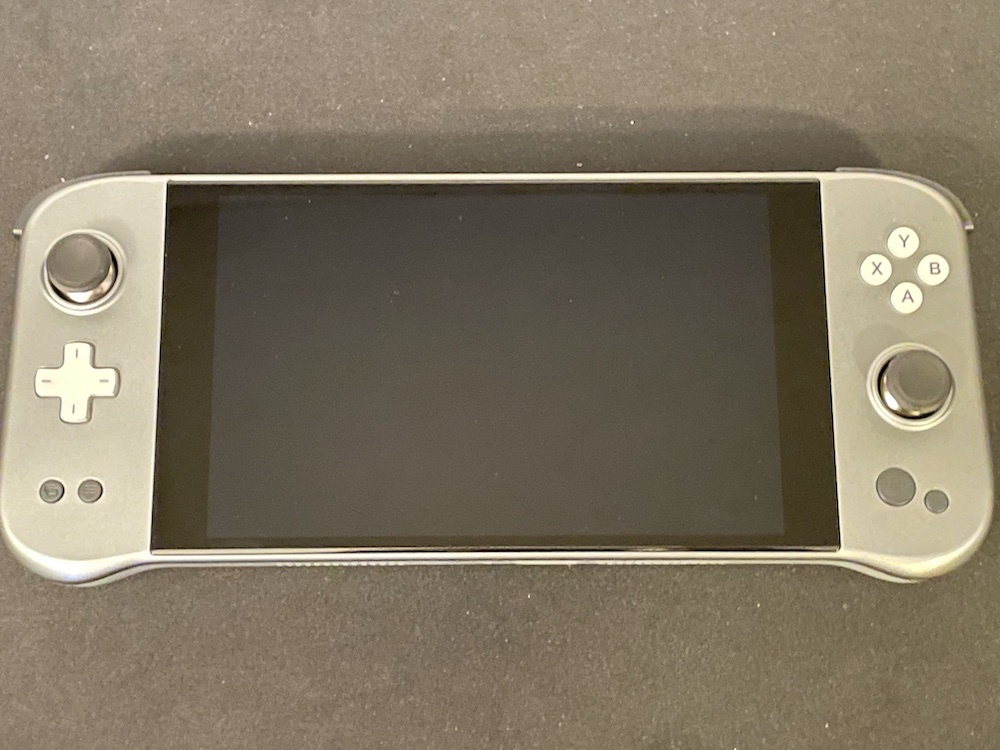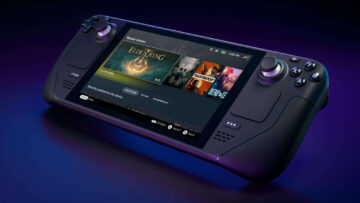The Aya Neo Next, a powerful handheld gaming PC, starts its crowdfunding campaign on February 15. If you’ve been following the surging handheld PC market, you may have heard of the Aya Neo already. Earlier this year I reviewed the Aya Neo Pro, a device that reached Indiegogo backers’ hands just several months back. Although the Aya Neo Pro was and still is quite impressive, I mentioned in my review that a revamped version of the Aya Neo was on the horizon. I’ve now had a chance to check out the Aya Neo Next ahead of its launch next month, and I can confidently say that if you’re interested in the Aya Neo brand, the Next is the version to pick.
The Aya Neo Next is more of an iteration on the existing Pro and 2021 models than a brand-new handheld. It still shares the same core DNA, as a Windows handheld PC with an AMD mobile processor and integrated Radeon Vega graphics. If you already have the Aya Neo Pro, upgrading to the Next probably doesn’t make much sense. If the Next included a 6000 series processor–instead of the 5000 series–it might be a different story, but as it stands, the Next feels more like the definitive version of the company’s initial move into the handheld PC gaming market.
It may seem strange that a new Aya handheld is launching just several months after its predecessors, but if you think about it from a PC gaming perspective–where minor component upgrades release regularly–it makes sense. Even though this an iterative upgrade, the Aya Neo Next boasts significant improvements in terms of build and moderate performance improvements.
Note: For a more in-depth look at the Aya Neo’s features, check out our Aya Neo Pro review. This article is intended to detail the improvements found in the Next.
Exceptional ergonomics
The Aya Neo Next has a stellar form factor. Despite the fact that the handheld is fairly heavy compared to mainstream devices like the Switch, the Next is the most comfortable portable gaming device I’ve ever held. With subtle curvatures and rounded handles along the back to mimic a conventional gamepad, holding the Next feels completely natural. It’s like you’re gaming on a Switch with a form-fitting grip attached. Previous Aya Neo models were flat across the back and had more angular edges. The back of the Next has a rubberized, grippy feel to it. While I thought those models were comfy, the Next takes it to, well, the next level. The handheld comes in numerous color schemes, including Pastel Blue, Midnight Blue, Jet Black, Bright White, and silver (the one I tested).
The stellar feel extends to the handheld’s controls, most notably the triggers and analog sticks. Much wider and beefier than the Pro’s, the triggers feel like pockets for your fingers to rest in comfortably. The analog sticks also help in the ergonomics department, as they are larger and raised higher than the Switch-like thumbsticks found on the 2021 and Pro models. I found that the sticks were more accurate and had a finer range of motion, while the triggers were more sensitive to slight pulls, which is helpful in a wide variety of games.
The triggers and sticks are actually quite novel in design. The Next is the first handheld gaming console to use “Hall Effect” sensors. The analog sticks and the triggers have magnetic systems, which means that the components don’t physically rub up against each other when in use. In that sense, Hall Effect components aren’t subject to normal wear and tear. In theory, this should curb any possibility of drift or other unwanted miscues that are prevalent in many modern controllers, including Switch Joy-Cons. Since we only tested the Next for a few dozen hours, we can’t truly comment on the longevity and durability of the components, but they are designed to last. Along with the Hall sensors, the sticks have a modular design, so it’s possible to swap them out to fit your preference. Out of the box, the Next has concave stick grips, similar to Xbox controllers.
The Next has slight differences elsewhere in terms of design. The various menu and setting buttons have been reduced from six to four, and two of them have brand-new functionality. Both of these buttons are unlabeled. The larger one pulls up a quick menu for Aya Space, a proprietary software that makes managing your games and experience feel like a proper gaming console. Aya Space is available on all models of the Aya Neo, but the Next has it preinstalled. The smaller blank button offers a one-click option for exiting windows, which comes in handy on a PC like this. I don’t think the Xbox Game Bar and keyboard buttons on the Aya Neo Pro were particularly necessary, and the Next has a cleaner, less cluttered look by dropping them.
The power button on the Next doubles as a fingerprint sensor for login, which is a neat little feature. The sensor works well as long as it’s not smudged, but there have been a few times I’ve had to wipe it off to get it to register. You can still enter your Microsoft password or use a unique pin to unlock the device as well. The volume buttons and headphone jack are, as with the Aya Neo Pro, located next to the power button. The Next only has two USB-C ports, which is one fewer than previous Aya Neo models. That’s a bit of a bummer, but it will only make a difference if you’re plugging multiple peripherals into the device at once.
Improved performance
As mentioned, the Aya Neo Next offers moderate performance improvements over its predecessors. The model I tested is equipped with an AMD Ryzen 7 5800U processor and Radeon Vega 8 graphics, whereas the Pro has a Ryzen 7 4800U processor and Vega 6 graphics. I noted in my Aya Neo Pro review that the difference between the Pro and the base 2021 model was negligible from a performance perspective. The Next’s performance improvements, on the other hand, are certainly noticeable.
Without tinkering with the TDP or fine-tuning visual settings within games, I was able to get noticeably higher frame rates and better fidelity with the Next than the Pro. And with some setting adjustments, most games I tried ran around 60fps or higher, including Grand Theft Auto V, Kena: Bridge of Spirits, Psychonauts 2, Forza Horizon 5, and the Tomb Raider Trilogy. Some outliers included Control and Halo Infinite, which hovered in the high 30s while still being playable. Finding the right balance of frames per second and visual fidelity is both unique to each game and the person playing it. And if you raise the TDP, at the expense of battery life, you can get even better results.
Since the Aya Neo’s 7-inch IPS display maxes out at 1280x800p resolution, the GPU doesn’t need to work as hard as it would for 1080p or 4K resolutions. In turn, this leaves more room for the GPU to work on rendering textures and keeping gameplay performance smooth. The Next uses the same screen panel seen in earlier Aya Neo models, which is perfectly fine considering it’s a lovely display. You’re not getting high-end graphical features such as ray tracing, but many games still look stunning on the Next’s display. Keep in mind that you can connect the Next to a monitor or TV and take advantage of better resolutions, but performance naturally takes a hit.
Though the Next is more of a natural step forward in performance for the Aya Neo brand rather than a giant leap, minor improvements in frame rate and visual settings can add up to make an impactful difference. That’s the case here.
Price and models
I tested the Aya Neo Next Advance, which has a 5800U processor and 16GB of RAM and 2TB of storage. The standard Next will have a slightly better 5825U processor, and the Next Pro will have the 5825U processor and 32GB of RAM instead of 16GB. Prices range from $1,265 to $1,565, and you save money by ordering when the crowdfunding campaign kicks off.
Yes, all Aya Neo models are pricey, but considering the Next is only slightly more expensive than the Pro (which starts at $1,215), the Next line is the ideal choice between the two. The significantly overhauled form factor and performance improvements make it worth the extra money. Of course, with the Steam Deck releasing later this month, it remains to be seen how the Next stacks up against the more affordable handheld PC from Valve. That said, there’s no denying the Aya Neo Next is an excellent handheld gaming device.
Specifications
| Aya Neo Next Advance | Aya Neo Next | Aya Neo Next Pro | |
|---|---|---|---|
| CPU | AMD Ryzen 7 5800U | AMD Ryzen 7 5825U | AMD Ryzen 7 5825U |
| GPU | Radeon Vega 8 | Radeon Vega 8 | Radeon Vega 8 |
| RAM | 16GB | 16GB | 32GB |
| Storage | 2TB | 1TB or 2TB | 2TB |
| Resolution | 1280 x 800 | 1280 x 800 | 1280 x 800 |
| Display | 7-inch IPS touchscreen | 7-inch IPS touchscreen | 7-inch IPS touchscreen |
| Battery Life | 2-5 hours | 2-5 hours | 2-5 hours |
| Ports | USB-C x2 | USB-C x2 | USB-C x2 |
| Price | $1,345 at launch / $1,465 | $1,265 to $1,465 | $1,465 (at launch) / $1,565 |
Steven Petite tested the Aya Neo Next for more than 30 hours. Aya Neo provided a sample unit.
- Coinsmart. Europe’s Best Bitcoin and Crypto Exchange.
- Platoblockchain. Web3 Metaverse Intelligence. Knowledge Amplified. FREE ACCESS.
- CryptoHawk. Altcoin Radar. Free Trial.
- Source: https://www.gamespot.com/articles/aya-neo-next-makes-an-already-great-handheld-gaming-pc-even-better/1100-6500570/?ftag=CAD-01-10abi2f
- "
- 2021
- 4k
- 7
- About
- accurate
- across
- adjustments
- ADvantage
- All
- AMD
- around
- article
- auto
- available
- battery
- Bit
- Black
- Box
- brand
- BRIDGE
- build
- Campaign
- case
- company
- company's
- component
- components
- Console
- Crowdfunding
- Crowdfunding Campaign
- department
- Design
- despite
- detail
- Devices
- different
- dna
- dozen
- expensive
- experience
- Feature
- Features
- fidelity
- fine
- fingerprint
- First
- fit
- form
- Forward
- game
- Gamepad
- gameplay
- Games
- Gaming
- GPU
- Grand Theft Auto
- graphics
- great
- Handy
- here
- High
- How
- HTTPS
- i
- image
- Included
- Including
- Indiegogo
- IT
- keeping
- Keyboard
- large
- launch
- launching
- Level
- Line
- Long
- longevity
- Mainstream
- managing
- Market
- May
- Microsoft
- Mobile
- model
- models
- Modern
- modular
- money
- Monitor
- months
- more
- move
- Neat
- NEO
- Offers
- Option
- Other
- Password
- PC
- PC Gaming
- performance
- perspective
- Playing
- ports
- power
- powerful
- prices
- Pro
- raise
- RAM
- range
- Rates
- RE
- release
- REST
- Results
- review
- s
- Said
- Screen
- sense
- sensitive
- sensors
- Series
- setting
- Shares
- significant
- Silver
- SIX
- smaller
- So
- Software
- Space
- Stellar
- storage
- Story
- Switch
- Systems
- The
- theft
- triggers
- tv
- unique
- unlock
- upgrades
- USB-C
- valve
- version
- volume
- windows
- within
- Work
- works
- worth
- X
- xbox
- year


















